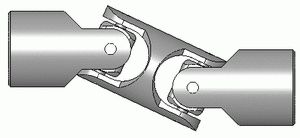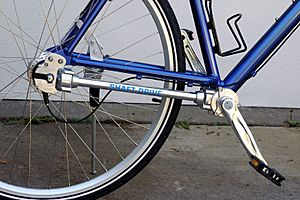Drive shaft facts for kids
A drive shaft is like a strong, spinning rod that helps move power from one part of a machine to another. It's often used to connect parts that are too far apart or need to move a little bit relative to each other. Think of it as a bridge for power!
Drive shafts are super important for sending power and torque (which is like twisting force) from an engine to the wheels of a vehicle. They have to be really strong to handle all that twisting without breaking or getting too heavy.
To let parts move and bend a little, drive shafts often have special joints. These are called universal joints, jaw couplings, or rag joints. Sometimes they also have a splined joint that lets them slide a bit.

Contents
History of Drive Shafts
The idea of a "drive shaft" started showing up in the mid-1800s. Back then, it was used to describe shafts that moved power in machines like wood planers or horse-drawn mowers.
By the 1890s, people started using the term more like we do today. For example, it was used for the shaft connecting the engine to the wheels on early trains and even on some of the first bicycles that didn't use chains.
The Autocar Company was the very first to use a drive shaft in a gasoline-powered car. This was in 1901, and that car is now in the Smithsonian museum!
Drive Shafts in Cars
Cars use drive shafts in different ways to get power to the wheels.
Front-Engine, Rear-Wheel Drive Cars
In cars where the engine is in the front and the power goes to the back wheels (like many sports cars or trucks), a long drive shaft runs from the front to the back. This shaft is often called a "propeller shaft."
Most of these cars have the engine and gearbox (transmission) together in the front. The drive shaft then connects to the rear axle. When the car is stopped, the drive shaft doesn't spin.
Some sports cars, like certain Corvette models, put the gearbox in the back of the car. This helps balance the car's weight better. In these cars, the drive shaft connects the engine in the front to the gearbox in the back. It spins whenever the engine is running, even if the car is stopped.
A shorter drive shaft that connects the rear axle to a single rear wheel is sometimes called a "half-shaft." This is because two of them make up one full rear axle.
Did you know? Early cars often used chains or belts to move power, not drive shafts!
Front-Wheel Drive Cars
In the UK, the term "drive shaft" usually means the short shaft that sends power to the front wheels. The longer shaft going to the back of a car is called a "propeller shaft."
There are a few types of drive shafts used in cars:
- One-piece drive shaft: A single long shaft.
- Two-piece drive shaft: Two shorter shafts connected by a joint.
- Slip-in-tube drive shaft: A newer type that can compress in a crash, making it safer. It's also called a "collapsible drive shaft."
Four-Wheel and All-Wheel Drive Cars
These cars have power going to all four wheels. They use a special gearbox called a transfer case. This case splits the power from the main transmission to both the front and rear axles.
So, these vehicles usually have at least two drive shafts: one going to the front axle and one to the rear axle. In bigger vehicles, there might even be a short drive shaft connecting the main gearbox to the transfer case itself.
Modern cars with all-wheel drive often have a setup similar to front-wheel drive cars. The engine and front axle gearbox are combined, and a single drive shaft runs to the back axle. This design is popular for cars that feel more like regular cars to drive.
Signs of a Bad Drive Shaft
A car's drive shaft can usually last for about 120,000 kilometers (about 75,000 miles). But if you notice any of these signs, it's a good idea to get it checked out:
- Clicking or squeaking noises: You might hear these sounds from under the car while driving.
- Clunking sounds: These noises often happen when you turn, speed up, or even put the car in reverse.
- Vibration: A common sign is a strong shaking coming from underneath the car. This can be caused by worn-out parts in the drive shaft.
- Turning problems: If you have trouble turning the vehicle, especially at different speeds, it could be a sign of a drive shaft issue.
Drive Shaft Park Brakes
Some smaller trucks use a special parking brake that works on the drive shaft itself, instead of directly on the wheels. These are sometimes called "Cardan shaft park brakes."
It's very important to use these brakes correctly, especially on hills. If not applied with enough force, or if the truck's load shifts, the truck could roll away. That's why it's always a good idea to use wheel chocks (blocks) on the wheels when parking on a slope, especially with a heavy load.
Motorcycle Drive Shafts
Drive shafts have been used on motorcycles for a long time, even before World War I. They are an alternative to chains or belts.
Advantages of shaft drive on a motorcycle:
- They last a long time.
- They are clean and don't get greasy like chains.
- They need less maintenance.
Disadvantage of shaft drive on a motorcycle:
- They need special gears to turn the power 90 degrees to the rear wheel, which can cause a small loss of power.
Many famous motorcycle brands, like BMW and Moto Guzzi, have made motorcycles with shaft drives. Japanese brands like Honda, Suzuki, Kawasaki, and Yamaha have also produced them.
Some motorcycles have their engine's crankshaft (the main spinning part) running lengthwise, parallel to the bike's frame. This design is great for shaft drives because it only needs one 90-degree turn for the power to reach the wheel.
Motorcycles with shaft drive can sometimes have a "shaft effect," where the back of the bike feels like it lifts up when you speed up. Companies have developed special systems, like BMW's Paralever, to counteract this.
Marine Drive Shafts
On a boat with an engine, the drive shaft (or propeller shaft) connects the engine inside the boat to the propeller outside. It goes through a special seal in the boat's body to keep water out.
The force that pushes the boat forward, called "thrust," is sent from the propeller through the drive shaft to a special part called a "thrust block" or "thrust bearing." This block is usually part of the engine or gearbox.
The part of the drive shaft that connects directly to the propeller is called the tail shaft.
Locomotive Drive Shafts
Old steam locomotives like the Shay and Climax used drive shafts. These shafts connected a central engine to the wheels of the train. They had special joints that allowed them to bend and slide, which was important for the train to go around curves.
Modern diesel locomotives and electric locomotives also use drive shafts, especially those that are diesel-hydraulic. They are also very common in diesel multiple units (trains made of several connected cars).
Drive Shafts in Bicycles
For over a hundred years, some bicycles have used drive shafts instead of chains. They haven't become super popular, but they have some interesting pros and cons.
Advantages of Shaft-Driven Bicycles
- The drive system is less likely to get jammed.
- You won't get chain grease on your clothes or get caught in the chain.
- They need less maintenance if the drive shaft is inside a tube.
- They can offer more consistent performance.
Disadvantages of Shaft-Driven Bicycles
- A drive shaft system usually weighs more than a chain system (about 0.5 to 1 kilogram more).
- It's not possible to use lightweight derailleur gears, which offer many different speeds. However, hub gears (gears inside the wheel hub) can be used.
- Removing the wheel can be a bit more complicated with some designs.
PTO Drive Shafts
Drive shafts are also used to power extra equipment on vehicles, like air compressors. This is common when there isn't enough space near the engine for the equipment. The drive shaft acts as a bridge, letting the equipment be mounted somewhere else on the vehicle while still getting power from the engine's PTO (Power Take-Off) unit.
|
See also
 In Spanish: Eje de transmisión para niños
In Spanish: Eje de transmisión para niños





